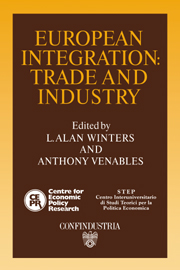Book contents
- Frontmatter
- Contents
- List of figures
- List of tables
- Preface
- Acknowledgements
- List of conference participants
- 1 European integration: trade and industry
- 2 Completing the internal market in the EC: factor demands and comparative advantage
- Discussion
- 3 External effects and Europe's integration
- Discussion
- 4 The quality and production of textiles and clothing and the completion of the internal market
- Discussion
- 5 Competition and imports in the European market
- Discussion
- 6 The structure and determinants of East–West trade: a preliminary analysis of the manufacturing sector
- Discussion
- 7 1992 and EFTA
- Discussion
- 8 Technology policy in the completed European market
- Discussion
- 9 Corporation tax, foreign direct investment and the single market
- Discussion
- 10 Japanese direct manufacturing investment in Europe
- Discussion
- Index
1 - European integration: trade and industry
Published online by Cambridge University Press: 07 September 2010
- Frontmatter
- Contents
- List of figures
- List of tables
- Preface
- Acknowledgements
- List of conference participants
- 1 European integration: trade and industry
- 2 Completing the internal market in the EC: factor demands and comparative advantage
- Discussion
- 3 External effects and Europe's integration
- Discussion
- 4 The quality and production of textiles and clothing and the completion of the internal market
- Discussion
- 5 Competition and imports in the European market
- Discussion
- 6 The structure and determinants of East–West trade: a preliminary analysis of the manufacturing sector
- Discussion
- 7 1992 and EFTA
- Discussion
- 8 Technology policy in the completed European market
- Discussion
- 9 Corporation tax, foreign direct investment and the single market
- Discussion
- 10 Japanese direct manufacturing investment in Europe
- Discussion
- Index
Summary
The completion of the internal market in the European Community (EC) has now been the subject of much research. The likely direct effects of ‘1992’ have been catalogued and quantified, and the possible implications of these changes for trade and industry have been estimated. Emerson et al. (1988) provides the best overview of this work, and it is fair to say that something of a consensus has developed around it. ‘1992’ is expected to increase competition, encourage some rationalisation of industry and thereby generate efficiency gains, possibly yielding net benefits amounting to several per cent of EC income.
Comforting though the consensus is, it is built on relatively shaky foundations. Emerson et al. (1988) represents a high point of applied economics, combining the results of several different modes of analysis in an original and innovative fashion. The study did not, however, have the time, or the intention, to explore the mutual consistency of such approaches, nor to elucidate the precise mechanisms involved in some of the economic relationships assumed. Nor, of course, did it examine the full range of consequences and alternative approaches to predicting the effects of ‘1992’. These tasks have fallen to academic researchers. While there has been a huge volume of comment and casual analysis of the completion of the market, the detailed work required to analyse these issues is only just beginning to appear.
The studies in this volume comprise a number of explorations going beyond the Emerson consensus. They do not offer a comprehensive reappraisal of ‘1992’, but rather seek to examine particular issues in greater detail.
- Type
- Chapter
- Information
- European IntegrationTrade and Industry, pp. 1 - 8Publisher: Cambridge University PressPrint publication year: 1991



